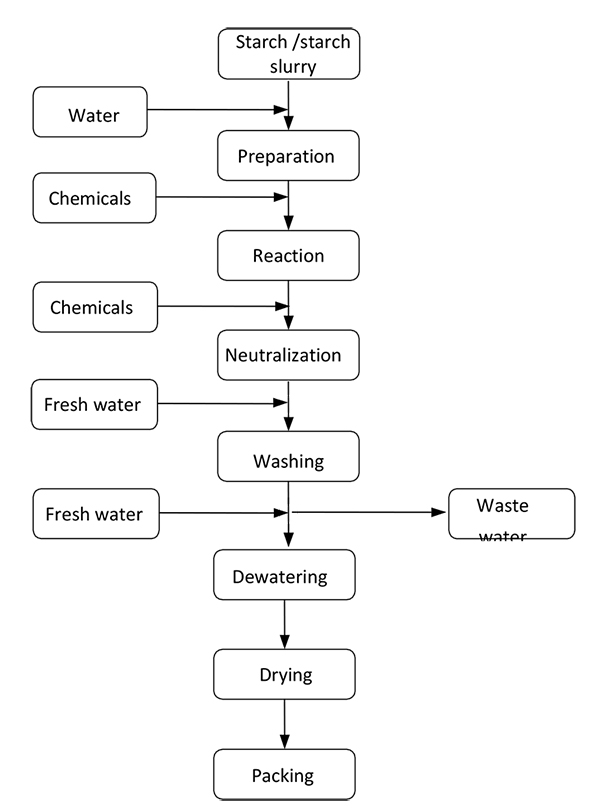


Product Advantages
1.Combining the mature European technologies and domestic production in high standard, makes our system of the best performance-price ratio.
2.Fully closed and modular structure makes compact layout, resulting in a sharp reduction of installation time.
3.Steady running control system range from fully automatic to manual, catering to customers’ needs for various systems.
4.By utilizing 3D design software, detailed drawings can be provided for customers’ facilitated installations.
System Flow Chart

Technical description
1. Preparation of starch slurry
Ideal raw material for wet method processing technology of modified starch is native starch milk directly from native starch production line. Compared to the use of commercial starch as raw material the use of native starch milk can save the effort and related cost of drying starch slurry and packing of commercial starch and the processing of commercial starch into starch milk and so is economic and convenient. But the disadvantage is that in that way the production capacity should be limited by the sufficiency of fresh potatoes. Most manufacturers of modified starch choose to start with commercial native starch.
At the beginning of the production of modified starch, the quantity of native starch (on the basis of dry substance) should be strictly calculated. At the same time the quantity of water and chemicals to put in should be calculated according to the formula of modified starch.
Refined native starch will be discharged to the mixing tank to produce slurry with concentration of 21 Baume. Only soft water can be added during the process.
The starch milk with 21 Baume Concentration will be pumped to the reaction vessel with calculating and balancing device at bottom which can control strictly the input quantity.
2. Reaction
Reaction is the key chain of the manufacturing of modified starch. In this stage the specification, quality and stability, and applied properties of final modified starch is decided. The factors which affect reaction unit are multiple which include proportion of raw material, concentration, reaction temperature, reaction time, PH value and agitation.
Starch milk in the reaction vessel will react with the chemicals added as per the formula of the modified starch under the help of agitator. Special agitators facilitate good blending and sufficient reaction of starch particles and chemicals. In the process of reaction the temperature of the starch milk should be kept at the best reaction temperature. That can be achieved by the panel-type heat exchanger filled with hot water or cold water to control the temperature. Chemicals always are discharged to the pipeline mixer where recycling starch milk will mix with it quickly and evenly to realize complete and timely reaction. During the reaction process PH of the starch milk should be monitored and acid or alkali will be added anytime to maintain the PH within the scope for the best reaction of system. Different kind of modified starch have different requirement of the reaction time. When the reaction comes to a conclusion, the PH of the starch milk should always be adjusted to be neutral and after that the milk will be sent to the buffer tank via starch milk pump. Subsequently evacuated reaction vessel will be used for next batch production.
All the operation and status should be controlled automatically in the unit of reaction. And manufacturing standard should follow strictly the production formula of the modified starch and comply with reaction conditions. Judge reasonably the ending of the reaction by on-time monitoring of the reaction status to get the expected quality end-product.
3. Washing of the starch milk
The modified starch milk after reaction still contains some chemicals and other unexpected products whose existence affect the quality of the final product. So washing is required to get rid of these impurities. In the case of wet method production of modified starch the most popular washing medium is water. And under the help of hydro-cyclone all unexpected foreign substances are removed to ensure the quality.
Starch milk in the buffer bank will be pumped to go through the circular vibrating screen to get rid of big particles of impurities. Modified starch milk under the screen flow directly into the buffer tank and then be pumped to the first stage washing cyclone. Washing water is added from the last stage washing cyclone and mix with the starch milk in a counter-current way. Refined modified starch milk finally will come out of the system from the last-stage cyclone and then be stored in the buffer tank for vacuum dewatering. On the other hand the waste fluid will be released from the overflow outlet of the first-stage cyclone. Because of existence of modified starch th waste fluid still need to be sent to two-stage recollecting cyclones to get back the modified starch. Recollected starch milk goes directly into the pipeline of the washing hydrocyclones to repeat the operation above. At last the water from overflow outlet of the last-grade recollecting cyclone contains no modified starch and then be drained to the sewage cistern.
Hydrocyclones are equipped with density meter, conductivity meter, electromagnetic flow meter, pneumatic control valve and similar automatic instruments. The washing efficiency and products stability can be guaranteed though automatic monitoring and automatic control. Adoption of hydrocyclones can realize complete cleaning efficiency and low consumption of water. Sanitary requirement can be met under such conditions of closed systems and no contacting with the air. Those are necessary for production of food-grade modified starch.
a) Dewatering
The concentration of modified starch milk flowing from hydrocyclones is around 19-21 Baume(dry substance is around 34%-38%) and it still need to be firstly dewatered before drying.
Adoption of centrifuge peeler for dewatering should pay attention to the details as follows: when the rotary drum rotate in full speed, the feeding valves will open at regular time. Starch milk will go via input pipe into the rotary drum and under the action of centrifugal force spread on the circular inner face of the filtering screen. And subsequently liquid-phase particles mostly pass through sieve and the holes of inner face of rotary drum and then are driven out of the tangential outlet. With the increase of working time the solid-phase material inside the drum accumulates slowing. When the preset time arrives feed inlet will close automatically and after some time the washing valve will open to allow the washing water to spray onto the liquid-phase material. After some time of spraying the valve will close and the drum will rotate in full speed and the liquid-phase matter inside will be constantly thrown out and solid-phase matter will be dewatered. Then the scraper will peel the layer of solid matter on the inner face off. Such dewatered starch pulp will be discharged from the collection groove by inclined discharging hopper out of the centrifuge peeler. When all are finished the scraper will reset. At the same time the washing valve will open and the sieve will be cleaned for next time of operation. Till now that is deemed a completion of a operation cycle. Then feed valve open again and a new working cycle starts.
The filter cake scraped off will subsequently be transported by the food-grade belt conveyor to the feed hopper of the flash dryer.
Because centrifuge peeler works intermittently a production line should be equipped with two centrifuge peeler to ensure the continuity of the production. Centrifuge peeler has good working performance and operation is convenient and stable. Dewatered starch cake contains less water which reduces energy consumption of subsequent flash drying.
b) Drying and packing
Moisture of commercial modified starch is required to be around 14%. Also special limits are imposed on the particle size of the starch. Flash dryer have high efficiency of heat conductivity and take shorter time to dry. The output product is powder.
Flash dryer will reduce the moisture of the dewatered starch to the level accepted by the commercial starch. Wet starch cake is discharged from food-grade belt conveyor and then goes into the throwing feeder of the flash dryer via the screw conveyor with hopper. In the throwing feeder the rotary propeller will break up the wet starch cake and then throw them into the drying pipe where the starch powder contacts with hot air from heat exchanger and quickly achieve heat exchange. Starch powder flow with the hot air and then go into the cyclone separator. After drying dried modified starch separate with wet hot air and goes via air locker and then are collected in the final product hopper while the hot air is discharged outside. During the drying process the moisture of commercial products can be stabilized by adjusting the speed of feeding screw conveyor.
Dried starch always has big particles which do not reach the standard and so need sieving before packing. Sieved starch is packed by the packing machine for commercial use.
Flash Dryer adopts negative pressure and the environment of negative pressure avoids the raising the dust of starch and thus create favorable working conditions. Air input is equipped with filtering device made of pharmaceutical grade material to ensure the purity of modified starch.
 online service
online serviceScan to wechat :
